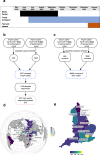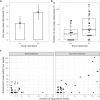Genomic assessment of quarantine measures to prevent SARS-CoV-2 importation and transmission
- PMID: 35197443
- PMCID: PMC8866425
- DOI: 10.1038/s41467-022-28371-z
Genomic assessment of quarantine measures to prevent SARS-CoV-2 importation and transmission
Abstract
Mitigation of SARS-CoV-2 transmission from international travel is a priority. We evaluated the effectiveness of travellers being required to quarantine for 14-days on return to England in Summer 2020. We identified 4,207 travel-related SARS-CoV-2 cases and their contacts, and identified 827 associated SARS-CoV-2 genomes. Overall, quarantine was associated with a lower rate of contacts, and the impact of quarantine was greatest in the 16-20 age-group. 186 SARS-CoV-2 genomes were sufficiently unique to identify travel-related clusters. Fewer genomically-linked cases were observed for index cases who returned from countries with quarantine requirement compared to countries with no quarantine requirement. This difference was explained by fewer importation events per identified genome for these cases, as opposed to fewer onward contacts per case. Overall, our study demonstrates that a 14-day quarantine period reduces, but does not completely eliminate, the onward transmission of imported cases, mainly by dissuading travel to countries with a quarantine requirement.
© 2022. The Author(s).
Conflict of interest statement
The authors declare no competing interests.
Figures




References
Publication types
MeSH terms
Grants and funding
LinkOut - more resources
Full Text Sources
Medical
Miscellaneous

